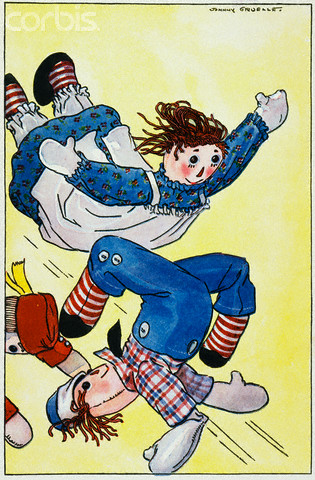The release of 25 percent of the state’s prison inmates might prove a tad controversial. [Kerr, Volokh]
New Amazon Kindle: Hey, those audio rights are ours!
Thrift stores, the day after
The Houston thrift shop in the video above is by no means alone. Elsewhere in the country, many resale stores are either closing their children’s sections entirely or drastically curtailing the line of goods they carry. Among them is Goodwill of Kansas (press release):
Painted toys and clothing with metal clasps or fasteners — including blue jeans, coats and hooded jackets for children 12 and younger — were pulled from store shelves Monday night, said Gayle Goetz, vice president of development for Goodwill Industries Easter Seals of Kansas.
The move affects 14 Goodwill stores in Kansas, including three in Wichita and one in Maize.
“We kept hoping we’d get some guidance, so we waited,” Goetz said. “We had our legal committee look at it last night and determined that there’s just too much liability.”
Half the supply of children’s clothing is gone at Omaha-area Goodwill for similar reasons (KPTM video).
At the same time, many other thrift stores nationwide are for the moment proceeding with business as usual, leaving kids jeans’, plastic playthings, pre-1985 books and other suspect items on the shelves, whether because they are breezier about taking on risks of liability, because they are unfamiliar with the law, or because they figure its terms are too irrational to actually be enforced. And even when they are withdrawing items from sale, some, like Goodwill of Kansas, are placing them into storage in the expectation that Congress will see reason (insert joke of choice here) and act to change the law soon.
Others, especially stores that specialize in kids’ resale, are thinking of closing their doors because of CPSIA or have already done so. “I have everything to lose,” said owner Kasey Brown in Ionia, Mich., who closed her Hey Baby Boutique a few days ago. (See also Maine and Arkansas items from our recent 50-state roundup).
One presumably unintended consequence will be to deprive nonprofit community and religious groups of millions of dollars in revenue with which they had pursued worthy causes. In the Charlotte area alone, kids’ resale at Goodwill is a $2 million business that supports job-training programs, the local director says. In an Indiana newspaper, a Salvation Army source is quoted as saying that the CPSIA blow could wipe out more than 16,000 places in drug and alcohol rehabilitation programs supported by the stores.
In Bend, Oregon, according to ABC affiliate KOHD, consignment store Stone Soup decided to take the unusual step of screening its stock for lead using the X-ray fluorescence method. It cost $1,500 a week to rent the equipment, 30 percent of tested items failed (lots of zippers, rhinestones and skateboards out there with lead content), and the store found itself having to fill out scads of paperwork since each failure had to be reported to Washington under the law’s defect-notification provision.
In his stump speech five years ago, presidential candidate John Edwards (as Alex Tabarrok noted at the time) was
fond of empathizing with the plight of a 10-year old girl “somewhere in America,” who goes to bed “praying that tomorrow will not be as cold as today, because she doesn’t have the coat to keep her warm.”
As John Tierney of the New York Times countered, however, whatever real economic problems America had in 2004, children going without serviceable winter clothes because their parents lacked money was not high on the list: “The second-hand children’s coats that remain in America typically sell for about $5 in thrift shops.”
Way to solve that problem, Congress.
More: Thrift-store shutdowns in Florida and Kansas, “truckloads” removed from Goodwill stores in Louisiana, shelf-clearings and disruptions in Virginia, upstate New York and Waco, Texas. Tucson resaler Casa de los Ninos reports taking a $70,000 hit from inventory suddenly rendered worthless. That can’t be easy to incorporate into the economics of running such a place, but maybe the owner can just go without taking a salary for a year or two. I’m sure some CPSIA proponents will say it’s his own fault for not informing himself better about the law in advance.
CPSIA: “Black Tuesday” for youth motorbikes

We blogged earlier about Honda’s and Kawasaki’s having pulled out of the U.S. market and ordered a halt to sales of their youth motorbikes. A similar Jan. 26 letter from third big maker Yamaha is reprinted here, and smaller makers are rumored to have taken the same step.
Thiel’s Wheels of Ohio: “We cannot sell you replacement parts for the ones you already own. This is not our decision; it is being made for us.” DealerNews (“The Voice of PowerSports Retailers”): “The value of inventories that now cannot be sold is unknown, but it probably exceeds $100 million, by our estimate. Just take 7,500 franchised dealers, many of whom carry $25,000 worth of inventory at wholesale cost.” Activism/protest ideas there and at Dirt Rider.
W.V. doc who generated 124 malpractice claims
Yes, he’s back in court: Dr. John A. King is now suing, for $50 million, the lawyer he hired to sue the three law firms that represented him previously. “King has an extensive history of suing hospitals who terminated his privileges, medical boards who took away his licenses and lawyers he hired to represent him.” Putnam General Hospital, where he previously practiced, and HCA have paid out around $100 million to settle claims against King. [Charleston Sunday Gazette-Mail].
Mississippi break
Dickie Scruggs pleads guilty in a second Mississippi judicial-corruption case, and prosecutors say more indictments will be unveiled shortly. [NE Miss. Daily Journal, Alan Lange/YallPolitics, NMC/Folo]
CPSIA and vintage books
As readers are aware, the Consumer Product Safety Commission yesterday advised thrift stores and other resellers and distributors of used goods to discard (unless they wished to test for lead or take other typically unpractical steps such as contacting manufacturers) children’s books printed before 1985 and a very wide range of other children’s products, including apparel and playthings.

According to a commenter at a very busy Etsy thread on the subject, stores are already beginning to act on this advice:
I just came back from my local thrift store with tears in my eyes! I watched as boxes and boxes of children’s books were thrown into the garbage! Today was the deadline and I just can’t believe it! Every book they had on the shelves prior to 1985 was destroyed! I managed to grab a 1967 edition of “The Outsiders” from the top of the box, but so many!
People who deal more systematically in children’s books for a livelihood now face unpleasant choices. From our comments section, Valerie Jacobsen:
We own a small, local used bookstore and have been selling used books on the Internet since 1995.
Last year we shipped over 4500 used books to nearly 50 countries. (Note that CPSIA not only regulates distribution and sale but export as well.)
Our bookstore is the sole means of income for our family, and we currently have over 7000 books catalogued. In our children’s department, 35% of our picture books and 65% of our chapter books were printed before 1985.
Many of our older children’s books have painted decorative titles and other cover embellishment, which decoration is an extremely small quantity and which may or may not contain over 600 ppm lead. (The limits for each accessible part or paint layer are going to 300 ppm in August and 100 ppm in 2011.)
We have read the legislation, called our representative, called our senator, contacted the CPSC (no answer), read all of the CPSC press releases, and contacted a lawyer. We still honestly have no idea what is legal to sell, but we cannot simply discard a wealth of our culture’s nineteenth and twentieth children’s literature over this.
And from the same commenter today, following up after the CPSC’s issuance of guidance to small businesses last night:
I wasn’t thrilled with the exception stating that we can sell pre-1985 children’s books as long as they are pricey vintage collectibles for adult collectors. Um, great, but most of our children’s books, even our older children’s books, are sold for children to read. And read them, they do.
We ran an audit in our bookstore today. We have about 7000 books catalogued. Of our children’s chapter books, about 65% are pre-1985. Of our children’s picture books, about 35% are pre-1985. Most of these sell for under $10 and are stocked as children’s reading.
As an ethical matter, I really can’t discard our cultural heritage just because the CPSC has decreed that books published through *1984* may or may not still form a legal part of the canon of children’s literature for our culture.
I was willing to resist the censorship of 1984 and the Fire Department of Fahrenheit 451 long before I became a bookseller, so I’d love to run a black market in quality children’s books–but at the same time it’s not like the CPSC has never destroyed a small, harmless company before. It’s a scary thing to know that what you are doing is a positive good for the community–and yet possibly, strangely illegal.
Also, I am comforted by no promises from Nord and Moore that are not clear consequences of CPSIA itself. The membership of the commission will probably be changed this year, and if Waxman gets much input into the new membership, we could end up with five first rate cuckoos.
To which commenter Carol Baicker-McKee responds:
Valerie, please, for the sake of children and history hang onto your books! I kept thinking this law would go away, but now I’m worried that an important part of our heritage is genuinely threatened. Many, many children’s books printed before 1985 are now out of print and do not exist still in a form that would make them easy to republish (printing plates are usually destroyed when a book goes out of print and older books did not have electronic versions). Many books, though of enduring value to children and social scientists, may not exist in conditions or simply don’t fall into categories that make them appealing to collectors, the one group besides packrats that I guess is still allowed to own them. Although organizations like the Gutenberg Project have been working to scan and preserve many older children’s books in electronic form, they can only target books that are no longer copyright protected, a very small portion of the children’s books printed since 1985.
If nothing happens to change this law soon, I promise I will spend whatever money and devote whatever space I can to buying up these older books. I’ll be happy to label myself a collector (and I’m subversive enough to leave the books lying around where kids might “accidentally” read them).
A “relabel everything as collectible” strategy is, however, of limited legal help to retailers, because the law provides that they are liable if they sell a product which will commonly be understood as destined for use by children, whether or not they label it as such.
Deputy Headmistress at Common Room, who has been a key CPSIA blogger, deals in second-hand books and has now pulled many of her listings off Amazon; she has a big roundup as well as this. She also points out, citing testing done by Jennifer Taggart, that color illustrations in some old children’s books do flunk the new and stringent rules set by CPSIA for lead content; this does not necessarily mean they pose any hazard to actual children, provided the children use the books for reading and visual enjoyment rather than as something to chew, lick, or devour holes through, Very-Hungry-Caterpillar style. There continues to be an extreme shortage (as in: zero) of cited instances of children in this country being in fact poisoned by the lead in old book illustrations.
Design Loft carefully examines some of the implications for libraries, fiscal and otherwise, of trying to CPSIA-proof pre-1985 holdings. For weeks now librarian and bookseller groups have been sounding the alarm about the law’s coverage of books: Library Journal, Publisher’s Weekly and earlier, and ZRecommends, the American Library Association and more (PDF), Rick Woldenberg. Perhaps this activism helped stimulate the CPSC’s “post-1985 = relatively safe” guidance, but that guidance has only served to underscore the corresponding message of “pre-1985 = not legally safe”.
More: Mark Riffey, Iain Murray, CEI “Open Market”. And the American Library Association, contrary to what was heard earlier, is now taking the position that the law does not apply to libraries unless it hears otherwise. I think at this point if I were them I would take that position too, wouldn’t you?
More: Reactions from Houston criminal defense blogger Mark Bennett at Defending People and again at Blawg Review #199, Carter Wood at NAM ShopFloor and again, David Foster at Chicago Boyz, Der Schweizer Narr (from Switzerland, in German), The Anchoress, Todd Seavey, Open Your Ears and Eyes, Blackadder’s Lair, John Holbo/Crooked Timber, 5 Kids and a Dog, International House of Bacon (CPSIA “the single worst piece of regulation in my lifetime”), Vivian Zabel/Brain Cells and Bubble Wrap, She’s Right, Joey and Aleethea, Dewey’s Treehouse, Sherry/Semicolon Blog, and Classic Housewife.
Lawyers paid in gift cards, cont’d
Among the many reactions to our item last week on a Los Angeles judge who ordered that class action counsel be paid in gift cards (having negotiated only a gift-card settlement for the class) was one from Politics Across the Pond: “This should happen a lot more often, which would make it happen a lot less often.”
“PTSD Damages For A Non-Event”
We briefly mentioned the other day the remarkable litigation over a laptop theft which (it seemed at the time) might have led to a data breach imperiling the personal information of military veterans. The feared breach resulted in an emergency request to Congress for $160 million to provide credit counseling to veterans, and, more recently, a $20 million settlement of class-action claims brought against the Veterans Administration, based at least in part on allegations of emotional distress associated with the (unfounded, as it turned out) fear of identity theft. If you’re wondering who the biggest winner will be from all this, Bank Lawyer’s Blog is pleased to provide the answer.
CPSIA chronicles, February 10

Major provisions of the Consumer Product Safety Improvement Act take effect today, and last night the responsible federal agency, the Consumer Product Safety Commission, released a 13-page set of guidelines (PDF, updated link) for manufacturers and resellers, who thus enjoyed a generous few hours in which to review its myriad of bewildering details before opening for business on Tuesday and risking fines and prison terms under the law.
In general, the rules appear to hold little that is surprising or new, and thus serve to confirm that the law will prove a disaster unless quickly revisited and reformed by the U.S. Congress. To take just one example, that of resale, thrift and consignment stores, the CPSC guidance advises that such stores discard, or refuse to accept donations of, a very wide range of children’s items unless they are willing to test the items for lead or call their original manufacturer — neither of which steps is consistent with the economics of an ordinary small thrift store. Included in the suspect list are most children’s clothing (because most of it has snaps, buttons, zippers, grommets or other closures with unknown/unproved metal or plastic content), most books that were printed before 1985 or that (even if more recent) include metal or plastic elements such as staples* or spiral binders; most playthings (dolls, balls, trains, toy cars, etc.), most shoes and hair ornaments, most sporting goods, outdoor play items and wagons, board games when including any plastic spinners, tokens or other items, all bicycles and tricycles in kids’ sizes, most decorations for kids’ rooms, nearly everything with metal or synthetic applique, most school, art and science supplies, and on and on. A much diminished assortment of t-shirts, pullover sweaters, slip-on canvas shoes, unpainted/untreated wood blocks, post-1985 glued-spine books and a few like items might remain on the shelves, but for the most part, it now seems clear, the U.S. Congress in its wisdom has decided to banish the business of kids’ resale to the realm of outlawry, even when carried on by non-profits with unpaid volunteers.
I’ll have more later in the day. In the mean time, let me mention that Forbes.com has now published, in altered form, my 50-state survey of business distress, legal irrationality, and protest arising from CPSIA, which had earlier appeared here (on Sunday) as a blog post. Go check it out now!
*Although the 13-page guidance booklet itself is silent on the subject of staples, note the footnote to section 5 in the separate guidance on lead limits: “The term ‘ordinary book’ in this context means one that is published on cardboard or paper printed by conventional methods and intended to be read. It excludes children’s books that have plastic, metal or electronic parts.”
